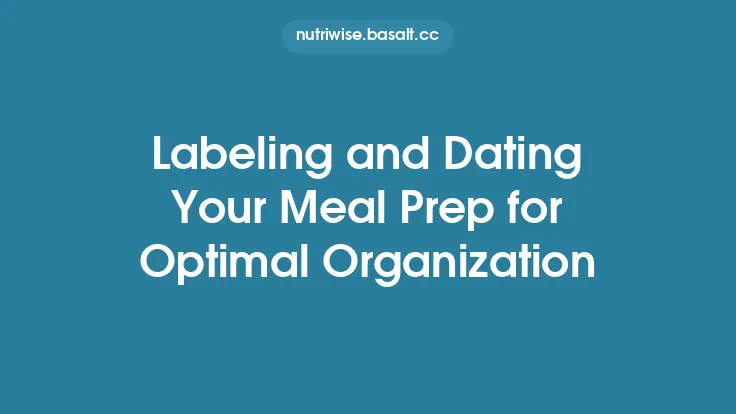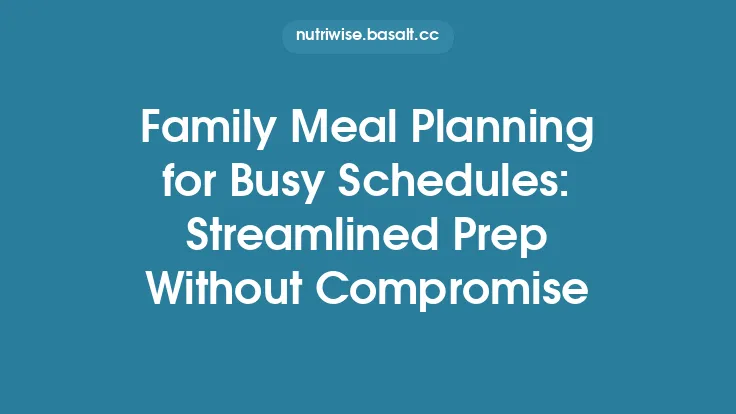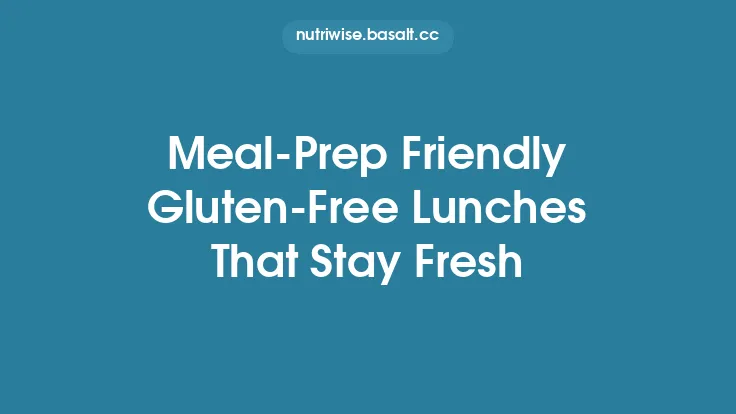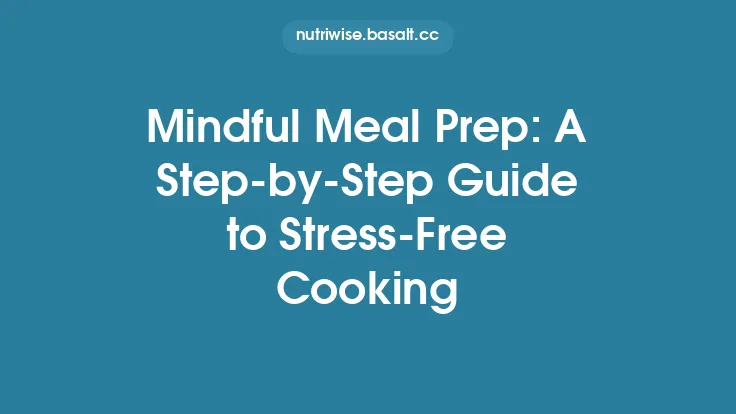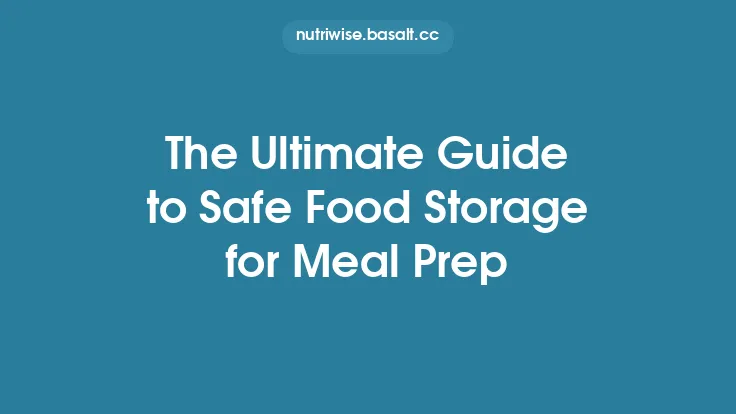Meal planning is only as smooth as the system you use to keep track of what you have, what you need, and what’s ready to go. While many planners rely on mental notes or handwritten lists, a well‑designed labeling system turns the chaos of weekly prep into a streamlined, repeatable process. By assigning clear, durable, and intuitive identifiers to every container, bag, and shelf, you eliminate guesswork, reduce waste, and free up mental bandwidth for the creative side of cooking.
The Core Benefits of a Robust Labeling System
- Instant Visibility – A glance at a labeled container tells you exactly what’s inside, how many servings it holds, and when it was prepared.
- Reduced Food Waste – Date stamps and “use‑by” indicators help you rotate stock before it spoils.
- Time Savings – No more opening multiple containers to find the right ingredient; the label does the work for you.
- Improved Portion Control – Labels that include serving size or calorie information make it easier to stick to dietary goals.
- Enhanced Consistency – When you repeat the same labeling conventions week after week, the entire prep routine becomes second nature.
Building Blocks of an Effective Labeling System
| Element | What It Covers | Why It Matters |
|---|---|---|
| Label Material | Paper, vinyl, polypropylene, dry‑erase, magnetic | Determines durability, resistance to moisture, and reusability. |
| Ink/Print Type | Permanent ink, laser toner, thermal transfer, waterproof markers | Affects legibility after exposure to heat, cold, or condensation. |
| Placement | Front, side, lid, or bottom of container | Ensures the label is visible in the storage location (e.g., freezer vs. pantry). |
| Information Hierarchy | Primary (food name) → Secondary (date, portion) → Tertiary (notes) | Guides the eye quickly to the most critical data. |
| Color Coding | Standardized palette for food groups, dietary restrictions, or prep stage | Provides an at‑a‑glance categorization system. |
| Digital Integration | QR codes, NFC tags, barcode links to apps | Bridges physical labels with recipe databases, inventory trackers, and shopping lists. |
Choosing the Right Label Materials
- Paper Labels – Ideal for short‑term use (e.g., daily meal prep). Use waterproof pens or a clear laminate overlay to protect against spills.
- Vinyl or Polypropylene – Flexible, tear‑resistant, and can withstand freezer temperatures down to –20 °F (–29 °C). Perfect for containers that move between fridge, freezer, and pantry.
- Dry‑Erase Labels – Reusable labels with a smooth surface that can be wiped clean. Best for containers you reuse daily, such as portion‑control jars.
- Magnetic Labels – Useful for metal pantry shelves or the side of a stainless‑steel fridge. They can be repositioned without adhesive residue.
- Thermal Transfer Labels – Printed with a heat‑press printer; they are smudge‑proof and survive high‑heat environments like microwaves and ovens.
*Tip:* Keep a small stock of each type in a “label drawer” so you can match the label to the container’s lifespan and storage conditions.
Designing Labels for Maximum Readability
- Font Choice: Use a sans‑serif typeface (e.g., Arial, Helvetica) at a minimum of 10 pt for legibility from a distance.
- Contrast: Dark text on a light background (or vice versa) ensures readability under low‑light pantry conditions.
- Hierarchy:
- Line 1 (Largest): Food name (e.g., “Quinoa‑Black Bean Salad”)
- Line 2 (Medium): Prep date and “Best By” (e.g., “Prep: Oct 5 2025 | Use By: Oct 12”)
- Line 3 (Small): Portion size, dietary tags, or quick notes (e.g., “2 servings | Vegan | Add lime before serving”)
- Icons: Small symbols (e.g., a leaf for vegan, a flame for “heat before serving”) can convey extra info without cluttering text.
Color‑Coding Strategies That Work
| Color | Typical Use | Example |
|---|---|---|
| Red | Perishables that need quick consumption | Fresh herbs, cooked grains |
| Green | Vegetarian/vegan items | Chickpea hummus, roasted vegetables |
| Blue | Seafood or dairy | Smoked salmon, Greek yogurt |
| Yellow | Gluten‑free or allergy‑specific | Gluten‑free pasta, nut‑free granola |
| Orange | Pre‑cooked proteins | Grilled chicken, tofu cubes |
| Purple | Freezer‑only items | Homemade broth, frozen fruit blends |
*Implementation:* Assign each color a specific purpose and keep a reference chart on the inside of a pantry door. Use colored label borders or background sheets rather than relying on ink color alone, as many label printers default to black ink.
Labeling Different Storage Zones
1. Meal‑Prep Containers (Refrigerator & Lunchbox)
- Label Placement: Front of the lid, where it’s visible when stacked.
- Key Info: Food name, prep date, “Eat By” date, serving count, reheating instructions.
- Special Note: If the container is microwave‑safe, add a small microwave icon.
2. Freezer Bags & Boxes
- Label Placement: On the side of the bag or the top of the box; avoid the seal where moisture can cause smearing.
- Key Info: Food name, portion size, prep date, “Freeze By” (usually 3 months from prep), thawing method.
- Durability Tip: Use freezer‑grade vinyl labels with a permanent adhesive; they stay stuck even after multiple defrost cycles.
3. Dry Goods & Bulk Staples
- Label Placement: Front of jars, canisters, or the top of bins.
- Key Info: Food name, purchase date, “Best By” (if applicable), quantity (e.g., “2 kg”).
- Optional: Add a small barcode that links to a pantry inventory app for automatic stock tracking.
4. Spice & Herb Containers
- Label Placement: Front of the lid; consider a small magnetic strip for metal spice racks.
- Key Info: Spice name, purchase date, “Best By” (most spices lose potency after 2–3 years).
- Pro Tip: Use a uniform label size and a consistent font so the rack looks tidy and the labels are easy to read.
5. Portion‑Control Jars (e.g., nuts, seeds, dried fruit)
- Label Placement: Front of the jar.
- Key Info: Food name, serving size (e.g., “¼ cup”), calorie count (optional).
- Benefit: Quick visual cue for snack portions, supporting balanced meal planning.
Integrating Digital Labels: QR Codes and NFC Tags
- QR Codes
- How to Use: Generate a QR code that links to a recipe page, a nutrition database entry, or a personal inventory spreadsheet.
- Placement: Print on a small sticker and affix to the container’s side.
- Advantages: One scan reveals all relevant data—ingredients, cooking instructions, and even a video tutorial.
- NFC (Near‑Field Communication) Tags
- How to Use: Program an NFC tag with a URL or a note in a note‑taking app (e.g., “Meal Prep – Chicken Curry – 2025‑10‑05”).
- Placement: Stick the thin tag on the lid; a tap with a smartphone reads the data instantly.
- Advantages: No visual clutter, and tags can be reprogrammed for reuse.
*Implementation Tip:* Choose a single app (e.g., Notion, Evernote, or a dedicated meal‑prep tracker) to store all linked data. Consistency prevents fragmented information across multiple platforms.
Maintaining an Evergreen Labeling System
- Weekly Review: Set aside 10 minutes after your Sunday prep session to scan all labels, update dates, and replace any that have peeled or faded.
- Label Refresh Cycle: Replace permanent labels every 3–4 months to avoid ink fading, especially for freezer items that are handled frequently.
- Standard Operating Procedure (SOP): Write a short SOP that outlines:
- Which label type to use for each storage zone.
- The exact wording format (e.g., “Food – Prep: MM/DD – Use By: MM/DD”).
- How to generate QR codes or NFC tags.
- Training the Household: If you share the kitchen, create a quick “Label Cheat Sheet” and place it near the prep area. This ensures everyone follows the same conventions.
Sustainability Considerations
- Reusable Labels: Invest in a set of dry‑erase or silicone labels that can be wiped clean and reused indefinitely.
- Eco‑Friendly Materials: Look for biodegradable vinyl or recycled‑paper labels for short‑term use.
- Minimal Ink: Use a laser printer with toner cartridges that last longer than inkjet cartridges, reducing waste.
- Bulk Label Production: Print a large batch of blank label templates (e.g., 100 × 25 mm) on a single sheet; cut them as needed to avoid excess packaging.
Troubleshooting Common Labeling Issues
| Problem | Likely Cause | Quick Fix |
|---|---|---|
| Label peeling in the freezer | Adhesive not rated for low temperatures. | Switch to freezer‑grade vinyl with a strong acrylic adhesive. |
| Ink smudging after microwaving | Water‑based ink not heat‑resistant. | Use laser‑printed labels or thermal transfer labels. |
| Labels hard to read in low light | Low contrast or small font. | Increase font size, use bold type, and ensure high‑contrast colors. |
| QR code not scanning | Code printed too small or on a curved surface. | Print at least 1 cm × 1 cm on a flat area; avoid curved containers. |
| Too many duplicate labels | No centralized label inventory. | Keep a master label list (digital or paper) to track which labels have been printed. |
Putting It All Together: A Sample Workflow
- Plan Your Menu – Decide on the meals for the week and list all components (grains, proteins, sauces).
- Prep & Portion – Cook each component, portion into reusable containers, and note the serving count.
- Print Labels – Using a template, fill in food name, prep date, use‑by date, and portion size. Add a color border based on your coding system.
- Apply Labels – Stick the label on the front of the lid (or side for freezer bags).
- Add Digital Layer – Generate a QR code that links to the recipe or nutrition sheet; affix it to the same container.
- Store Strategically – Place items in the designated zone (refrigerator, freezer, pantry) according to your color‑coded map.
- Weekly Audit – During your Sunday cleanup, scan each label, update dates, and discard any that have passed their “best by.”
Following this loop each week turns labeling from a one‑off task into a habit that continuously reinforces organization, reduces waste, and keeps your meal‑prep pipeline flowing smoothly.
Bottom line: A thoughtfully engineered labeling system is the silent partner behind successful weekly meal prep. By selecting the right materials, establishing clear visual hierarchies, leveraging color and digital technology, and committing to regular maintenance, you create an evergreen framework that saves time, cuts waste, and lets you focus on the joy of cooking rather than the logistics of finding the right container. Happy labeling!
